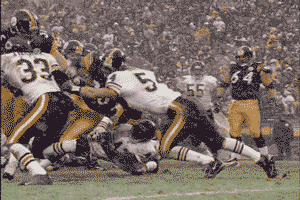Perhaps it's fitting that, after carrying the Steelers' offense for much of his career, Jerome Bettis got some help from a local scribe when it came to making his case for Canton.
Bettis, who retired after the 2005 season, wasn't elected to the Hall of Fame until his fifth year of eligibility. The two most common reasons given: There were more deserving players up for nomination, and more importantly, Bettis' numbers didn't stand out compared to other running backs -- at least on the surface.
The critics' go-to stat: Bettis averaged just 3.9 yards per carry during his 13-year career, a mark he didn't reach during any of his final four seasons. However, any discussion about that scarlet-numbered 3.9, which doesn't rank in the top 100 all time among running backs, has to be qualified with this disclaimer: Bettis was in his 30s, no longer a starter, and primarily used as a short-yardage back. These facts were often overlooked or dismissed when talking about Bettis' Canton candidacy.
The stats
But what do the numbers say, beyond conventional statistics?
The table below looks at Bettis' rushing yards, touchdowns, yards per carry, DVOA and DYAR, and Success Rate.
DVOA and DYAR are Football Outsiders' advanced metrics; DVOA measures a running back's value per play, compared to other running backs, and DYAR measures a running back's total value, compared to other running backs. (DVOA isn't a cumulative stat, while DYAR is.) Success Rate is another Football Outsiders' metric that "represents the player's consistency, measured by successful running plays (the definition of success being different based on down and distance) divided by total running plays."
| Jerome Bettis, through the years | ||||||
| Team | Year | YPC | Yards | TDs | DVOA (DYAR) | Success Rate |
| Rams (LA) | 1993 | 4.9 | 1,429 | 7 | 3rd (2nd) | 3rd |
| Rams (LA) | 1994 | 3.2 | 1,025 | 3 | 34th (38th) | 26th |
| Rams (STL) | 1995 | 3.5 | 637 | 3 | 39th (38th) | 41st |
| Steelers | 1996 | 4.5 | 1,431 | 11 | 4th (1st) | 3rd |
| Steelers | 1997 | 4.4 | 1,665 | 7 | 9th (4th) | 4th |
| Steelers | 1998 | 3.8 | 1,185 | 3 | 27th (26th) | 24th |
| Steelers | 1999 | 3.6 | 1,091 | 7 | 19th (13th) | 11th |
| Steelers | 2000 | 3.8 | 1,341 | 8 | 8th (6th) | 6th |
| Steelers | 2001 | 4.8 | 1,072 | 4 | 11th (10th) | 16th |
| Steelers | 2002 | 3.6 | 666 | 9 | 15th (19th) | 17th |
| Steelers | 2003 | 3.3 | 811 | 7 | 37th (38th) | 13th |
| Steelers | 2004 | 3.8 | 941 | 13 | 12th (11th) | 10th |
| Steelers | 2005 | 3.3 | 368 | 9 | 13th (18th) | 6th |
The Bettis backstory
Some things worth noting...
• The Rams went 5-11, 4-12 and 7-9 in Bettis' first three NFL seasons. After not seeing eye to eye with coach Rich Brooks, Bettis, the 10th overall selection in the '93 draft, was traded along with a '96 third-rounder to the Steelers for a '96 second- and '97 fourth-round pick. From '96 to '05, the Steelers went to the playoffs six times, including a Super Bowl victory (which, you may recall, came in Bettis' final season and took place in his hometown of Detroit, Michigan).
• Brooks, who replaced Chuck Knox before the 1995 season, installed a pass-heavy offense. That had a lot to do with Bettis' significant drop in production (637 yards after rushing for more than 1,000 in his first two NFL seasons). And when Brooks suggested that Bettis was better suited to be a fullback in his system, Bettis asked to be traded.
• Bettis rushed for more than 1,000 yards in his first six seasons in Pittsburgh, and scored 40 rushing touchdowns.

• In 2004, a year after then-coach Bill Cowher had benched Bettis for Amos Zereoué, Bettis played in 15 games (six starts) after offseason signing Duce Staley went down with an injury. He rushed for 941 yards and 13 touchdowns, and while the 3.8 yards per carry won't impress anyone, he was a big part of the Steelers' running game, a role that took on added importance when starting quarterback Tommy Maddox went down in Week 2 and was replaced by some fresh-faced kid named Ben Roethlisberger. Bettis ranked 13th in DVOA and 10th in Success Rate that season which, despite his advanced age, pointed to just how valuable he still was. As Football Outsiders explains it, backs with high DVOAs and a high Success Rate not only get the yards needed to make a play "successful," but also mix in long runs and is rarely stuffed at the line of scrimmage.
• This makes Bettis' final season even more impressive. He only rushed for 368 yards, but he had nine touchdowns while ranking 13th in DVOA and sixth in Success Rate.
• Fun facts:
Best runner in 1993, Bettis' first season: Emmitt Smith
Best runner in 1999, the midpoint of Bettis' career: Stephen Davis
Best runner in 2005, Bettis' final season: Larry Johnson
The support for Canton
From 2011-2014, when Bettis was eligible for the Hall, Marshall Faulk (2011) and Curtis Martin (2012) were the only running backs elected to Canton. Heading into 2015, skepticism remained that this would be Bettis' year. Luckily, the Bus had Steelers beat reporter and Hall of Fame voter Ed Bouchette in his corner. Bouchette, who covers the team for the Pittsburgh Post-Gazette made the same case he'd been making for years.
“He had knockout stats, a knockout career, everything you wanted in a Hall of Famer, he had it. Super Bowl, inspiration, played hurt, consistency, didn’t fumble, and he had the stats,” Bouchette told 93.7 The Fan in February. ... “Sometimes people want to turn [Bettis' longevity and durability] into a negative, like ‘well, he should have had all those yards, he had all those carries.’ Yeah, and every carry, a blow was delivered somewhere unless he ran untouched into the end zone because all those yards, all those carries, those were tough yards. He should be celebrated for lasting that long."
Ah yes, those blows delivered. Hall of Fame linebacker Derrick Brooks spoke about just that with Steelers.com's Teresa Varley.
“You know, I must admit, yes, there were a few collisions and let’s just say I wasn’t on the end I wanted to be," he said. "I didn’t lose many battles one-on-one in my career. But in my competition, my battles with Jerome, I didn’t win as many as I wanted to. His application is approved.”
By the way, consistency isn't a bad thing.
Congrats Bus. A true honor and joy to have coached a player who defined CLASS, CHARACTER & CONSISTENCY. Thanks for the memories.
— Bill Cowher (@CowherCBS) February 1, 2015
You can also ask Curtis Martin, who talked to Varley about Bettis' candidacy.
“Me being a running back, one of the things I would try to explain to them is how difficult it is to be a consistent running back from year to year,” Martin said. “How difficult it is to be dependable year to year. How difficult at running back it is to stay healthy. The work that you have to do just to stay on the field. The injuries you have to play with. You take more hits than just about anyone on the field.
"For Jerome’s full body of work, for him to do what he has done, for him to do it the way that he did. For him to be somewhat of a pioneer in my opinion, as far as a big guy who moved the way that he did. I don’t know that we really have ever seen it. The only person that I can think of that is even close to Jerome is Earl Campbell. I would tell them to look at his full body of work, where he is right now, at No. 6 on the NFL’s all-time rushing list. I don’t know how he is not in the Hall of Fame. I thought the guy would be in the Hall of Fame before I was.”
And that's the thing: Bettis was (conservatively) listed at 250 pounds but he wasn't just a bruising back. He had quick feet, elusiveness, could make himself "skinny" in the hole, and routinely ran away from defenders. In that sense he was a trailblazer and, undoubtedly, Hall-worthy.
Memorable moment
This list could legitimately be 10 games long but our favorite moment came in Bettis' final season, a Week 14 matchup against the Bears. The 7-5 Steelers had lost three in a row and needed to win their final four regular-season games to backdoor their way into the playoffs. Chicago came to Heinz Field with a 9-3 record and one the league's top-ranked defense.
So the 33-year-old Bettis, who tied a season-high with 17 carries, rushed for 101 yards, an average of 5.9 yards per carry. Not only did the Bus rip off a 39-yard run, he scored two touchdowns, including the unforgettable steamrolling of middle linebacker Brian Urlacher.

(You can see the YouTube evidence here.)
"Enough can't be said about Jerome Bettis," Hines Ward said after the game. "He epitomizes what the Steelers are all about. People think he's down and out and he comes out and has a game like he had today."
So did the Bus know that was Urlacher he stomped into the turf? Uh, yeah.
“I knew it was him,” Bettis admitted. “I was able to bang off of him and use his leverage against him. I knew it was going to be a big hit. I just tried to play off of it and keep those legs churning. He didn’t let go, but I’ve made a living off of carrying people – that’s why they call me The Bus.”
pic.twitter.com/zRSYbjqHKf before this game he told the Oline, "I'm warning you my brakes don't work!" He ran over several of us that nite!
— Kendall Simmons (@bigk73) February 1, 2015
The Steelers leaned on Bettis, who had previously rushed for a season-high 56 yards, because of the mix of mud and snow neutralized the speedy Willie Parker.
"There's a big difference between me and Willie Parker," Bettis said at the time. "He's the home-run guy. I'm the bunt, get on base, manufacture a score guy."
That's one way of putting it. More accurately: Bettis was the closer, the guy you gave the ball to when you needed those final three outs, even if he doesn't have his best stuff.
"I feel like crap," the Bus admitted. "But you know what? A win makes it feel a whole lot better. It's going to be a rough day tomorrow (Monday), but that's part of it. The fun part is being on the field, in that moment. It's priceless."
The Steelers won their final three regular-season matchups, earned a wild-card spot, and won three more road playoff games before defeating the Seahawks in the Silverdome to give Bettis a proper Detroit Super Bowl sendoff.
And on Saturday, Bettis will be inducted into the Pro Football Hall of Fame.
“I played the game of football with passion, with the desire to be a champion,’’ the Bus said in January, shortly after he was elected. “And in that drive to become a champion I have now put myself on the most sacred ground that a football player could ever be in, and that’s the Hall of Fame. I am humbled and grateful to all the voters who saw my career as being worthy of a gold jacket.”





















